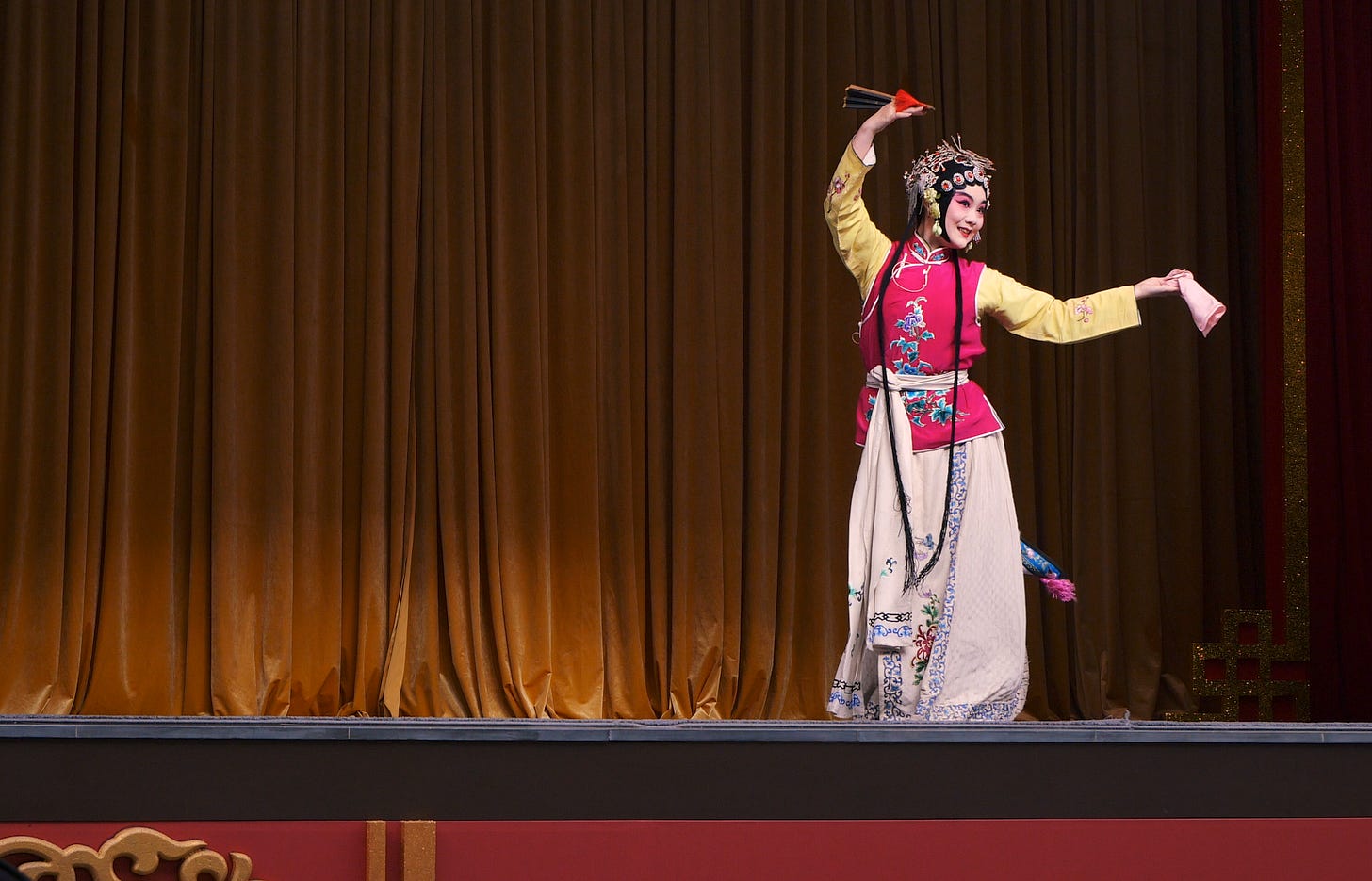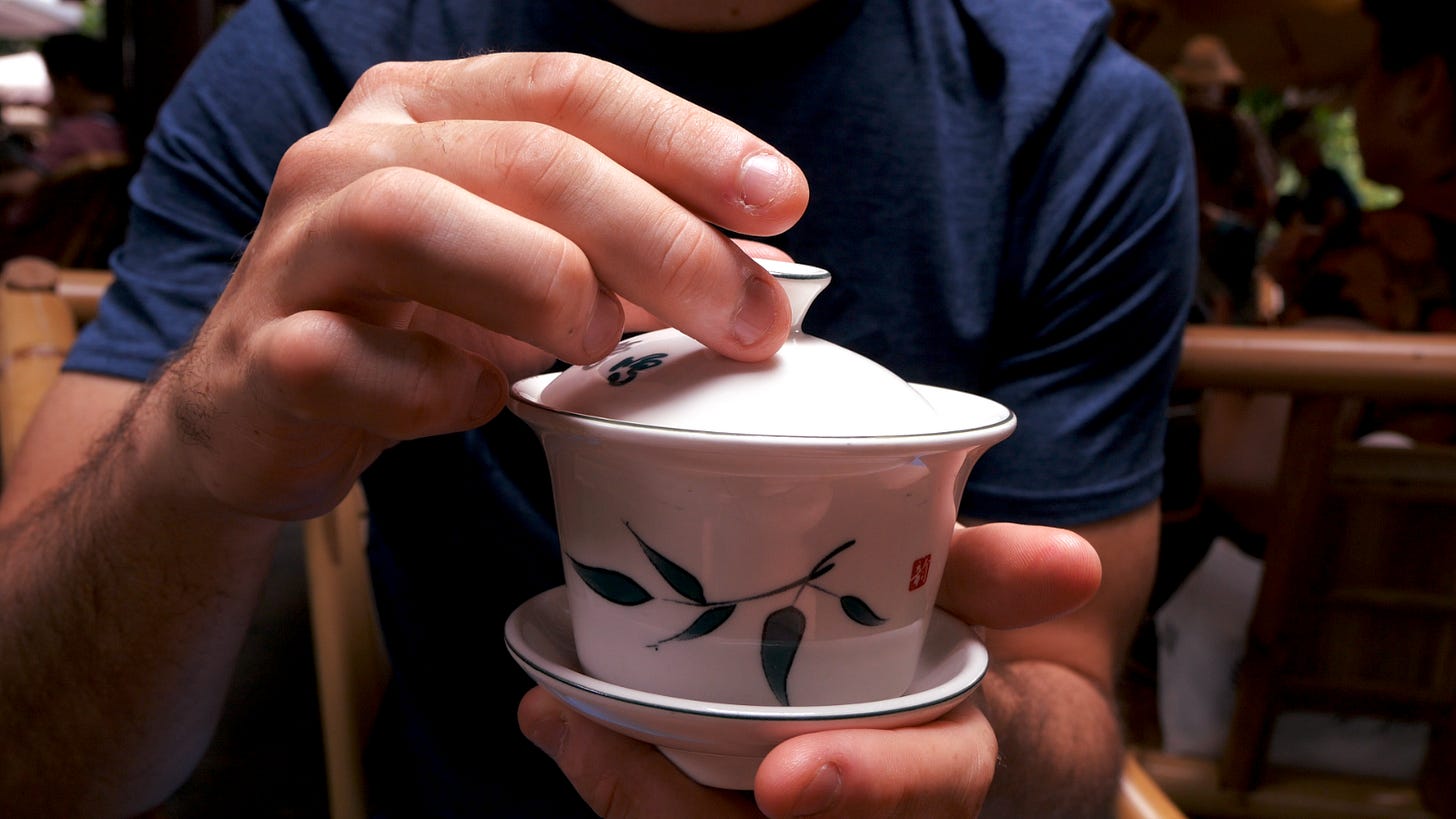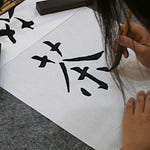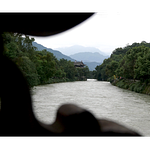For the umpteenth time the audience cheers as the actor swipes a fan across his face, changing his silk mask from red to yellow with a speed that defies logic. Pacing around the stage using martial arts footwork, he makes two rapid flicks of his neck, this time changing the mask from purple to black in quick succession. He’s reaching the climax of his变脸biàn liǎn, or face changing performance, and the small audience seated on bamboo sedan chairs is completely engrossed.
After the show, Tamzin and I leave the cool, stone opera pavilion amazed that such shows are being aired every week for free. We’re in Tianfu Opera Park, a recently-opened venue funded by the Sichuan Opera Research Foundation, which aims to promote “Sichuan tea appreciation, cultural and creative consumption, tourism and recreation.” The heat and humidity are punishing, so we hurry into an adjacent teahouse. It overlooks an artificial lake, beside which teenage girls are cosplaying as 武旦wǔdàn (warrior princesses), and taking selfies among the rock gardens.
A friendly, middle-aged waitress brings tea leaves over in two 盖碗 gàiwǎn (lidded porcelain cups), and fills them from a large thermos. While the teahouse is brand-new like the rest of the park, a genuine sense of deep history overrides the faux-ancient décor. Sichuan was the first area in the world to cultivate tea systematically, (Elvin, 2004) and its capital has more teahouses than any other city in China, possibly in the world.
Alongside the agricultural stability ensured by the Dujiangyan Irrigation System, these teahouses created a laid-back, leisurely culture that largely survived the upheavals of the 20th Century, as humorously explained by Chen Zhong, antihero of Sichuanese novelist Murong Xuecun’s cult classic Leave Me Alone:
If cities were people, Chengdu would be a happy drifter with a fatal lack of ambition. Chengdu’s soft dialect melts your ear: it’s said that it can make a person’s anger dissolve instantly… Feet stretched out in a rattan chair with a glass of tea … their lives are like a fleeting dusk. (Murong 2009)
Around us, people of all ages are engaged in archetypal pastimes associated with Chengdu tea drinking: playing chess, chatting, eating瓜子guāzǐ (melon seeds) and taking naps, but historically, teahouses were spaces for more than just leisure time. In his fascinating article The Idle and the Busy, Di Wang describes the 茶馆 cháguǎn of the late Qing and early Republic as unique sites of interclass mingling, where people of all walks of life would rub shoulders, strike deals, settle neighbourhood disputes or simply watch the world go by. The “Idle” referred to in the title were “local scholars, absentee landlords, retired officials, and other elites,” and the “Busy” were everyone else: “local opera performers and storytellers … merchants, doctors of Chinese medicine, craftsmen... food sundries peddlers and free laborers.” (Wang, 2000)
These venues were in many ways comparable to the first coffeehouses in London during the 1650s: a time when the caffeinated trinity of coffee, tea and chocolate arrived simultaneously, helping to shake off the “magical thinking that alcohol sponsored in the medieval mind,” replacing it with Enlightenment Rationalism. Those coffee houses (and later, tea rooms) were “uniquely democratic public spaces … the only such spaces where men of different classes could mix.” (Pollan 2021)
I take a sip of the amber, full-bodied brew, hesitant at first to add to my body heat, but immediately grateful for the tea’s mysterious ability to both cool and revive. Of the six common colours of tea in China – green, white, yellow, ‘clear,’ black and red – this is the latter. Red tea: ancestor of the leaves filling those ‘black’ teabags we Brits get through in the billions each year, misidentified by 17th Century British and Dutch traders due to the dark colour of its leaves.
I relax as the gentle high takes hold: slow and measured, not an aggressive jolt like that of coffee. It’s easy to see why this drink was embraced by the British as “a much-appreciated aspect of an “‘Enlightened’ consumer revolution,” encouraging the city elites to embrace “what they believed were Chinese beliefs and practices along with their tea and teaware.” (Rappaport 2017)
But by the 1850s, when most of the British industrial working class were addicted to bitter tea grown in Indian colonies – itself sweetened by sugar from Caribbean slave plantations – such Orientalism took a back seat. With Britain’s aggressive expansionism leading to the Opium Wars and the colonization of Hong Kong, anti-Chinese sentiment reached an all-time high. Racist propaganda manufactured food scares by claiming that “Chinese teas were adulterated with dangerous chemicals and bore the residue of sweaty and dirty Chinese laborers.” (Rappaport 2017)
Sitting here in this modest temple to the gentle art of tea, I reflect on how much gets lost when a cultural practice millennia in the making is hijacked, reduced to a simple means of extracting profit from human labour. As Japanese-American writer Okakura Kakuzo commented in his classic The Book of Tea: “The white man has scoffed at our religion and morals, but has accepted the brown beverage without hesitation.” (Kakuzo 1906) Now, we face the environmental fallout caused by this exploitative and reductive capitalism.
But as I pour fresh water over my tea leaves from the thermos, I realise that for all the damage it caused, The British Empire could not destroy the meanings, cosmology and rituals that persist in Chinese tea drinking today. The humble gàiwǎn I’m holding, for instance, is loaded with symbolism: the lid represents the sky; the saucer the earth and the cup the world and its people. The tea leaves inside are the chaos of the drinker’s life, making its ‘soup’ my life’s essence.
Draining the cup, I have the sense that some elemental characteristics of tea drinking survived the long passage to the UK from the Fujian coast, managing to reconfigure themselves in an alien setting. The idea of tea as both a conversational aid that cuts across the class divide and a core component of basic hospitality persists in both British and Chinese society to this day, making the relaxed environment of this teahouse feel oddly familiar.
Heading over to our bikes, I realise that this trip to the teahouse hasn’t only brought up the importance of learning from the mistakes of the past. It’s also reminded me of the ways in which our lives were inextricably linked with Chinese culture before ever coming here.
Eager to learn more about the culture that transformed the leaves of Camellia Sinensis into a consumer custom that shaped world history, we shoot a message to our Chinese teacher Stephanie, get on our bikes and head south.
Stay tuned for Part 2 of this article next week, in which Stephanie takes us on a deep dive into the history, mythology and culture surrounding tea. And at the end of this month, we'lll share a video taking you with us on an a tea-themed adventure!
Connect with us on Instagram or Twitter
Sources:
Elvin M (2004) The Retreat of the Elephants: An Environmental History of China, Yale Books
Juenong W (2005) An Illustrated Reader of The Classic of Tea (trans. Tony Blishen), Shanghai Press
Kakuzo O (1906) The Book of Tea, Digreads.com
Martyris N (2016) When Britain Fought Against the Tyranny of Tea Breaks, NPR
Murong X(2009) Leave Me Alone: A Novel of Chengdu, Make-Do Publishing
Pollan M (2021) This is Your Mind on Plants, Penguin Publishing
Rappaport E (2017) A Thirst For Empire: How Tea Shaped the Modern WorldPrinceton University Press, Princeton University Press
Wang D (2000)The Idle And the Busy: Teahouses and Public Life in Early Twentieth-Century Chengdu, Journal of Urban History, and taking selfies among the rock gardens.

















Share this post